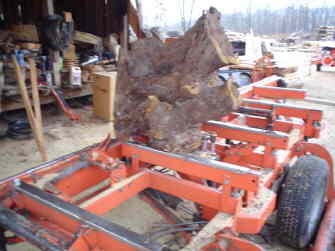Question
I am digging out the stump of a recently cut walnut tree to experiment with in my wood working. I need some guidance to cut and dry to wood to minimize cracking of the wood.
I have the following questions:
1. It is July. To minimize cracking of the wood during ambient air drying is it better to wait until later in the year to dig out and cut up the stump? If so when?
2. To avoid cracking of the wood pieces I am planning to use parafin wax. Do I need to coat the entire piece or just the end surfaces?
Forum Responses
(Sawing and Drying Forum)
From contributor V:
I am assuming you are going to slice it? What thickness? Is the wood solid? I have had good success in drying this sort of material, but I need some more details.
I was advised to remove it intact and paint the cut surfaces and to then let it dry as a whole piece. This is my first experience with this and I will be grateful for advice from anyone who has had experience.
If you're not going to slice it up now, leave it in the ground. But if you leave it there too long, bugs might be a problem and the top of the stump will start drying out and cracking. Maybe you could put in some pictures to show what the grain looks like when you get it sliced up?
1. Cut it to size, and Anchor Seal/Wax the ends and a thinned application of seal/wax on the surface. Shellac is also a good option for the surfaces.
2. Coat the whole thing in WoodJuice from Preservation Solutions. It is not cheap but it works. Apparently it keeps the cell-structure from collapsing during drying, thus allowing the internal to dry while the outside remains intact (cells do not shrink). If I have "trouble material" that is valuable and/or important to me, this is my choice.
3. A third option, which the above respondent mentioned was to slow the drying down (essential what #1 is doing). I've had good success in drying walnut crotches in my below-grade (damp) basement.
In summary, it's a cost-benefit analysis you must calculate. #2 is most costly but almost a sure bet, #1 is very good but slower and more risky, #3 is easy and costs only some sweat, but is also slow!

If you were going to put it in the kiln right after sawing you would pass on the watered down coat of anchor seal on the surface, right? I have a walnut stump coming soon too.
I have a couple of additional questions:
1. In slicing it up, what are the best size pieces to make for slow drying and then re-cutting? Am I better off to cut them vertically as long as possible and leave them in 6 to 8 inch diameter pieces or to slice it horizontally in certain thickness and leave these pieces to be re-sawn later?
2. What about the roots? Should I not worry about keeping much of the root ends on the pieces? That would be easiest but if they are valuable to an experienced wood worker I would try to leave them?
3. When you say stress wood I assume you mean the areas that will have interesting and unusual grain. Will that be in the center of the stump or where the roots branch out and therefore throughout the stump?
It is interesting as I have sliced through several of the roots. When first sliced they appear to be the color of sap wood. At further inspection several days later the walnut color appears to be moving into the cut ends and coloring the wood. Are these large roots of value to turners if they are 10 to 18 inches in diameter and should I try to cut them out and dry them also?
Before you put much effort into this, I suggest that you take a hammer and knock some of the bark off of the top of the turn of the roots. This will give you a good look at the figure that you can expect. If there is a lot of wild amazing figure that you can't stop yourself from going after, then go for it.
If it is just sort of ok, you can find easier firewood than rendering it from this. While you are sawing this wood out, start thinking of how you would like to use it, because of its nature, it may not be all that easy to just work into any project that comes along. Long thin sweeping curves with a lot of grain run-out may look nice but won't have much structural strength. Also planks with the curve in the longitudinal axis make for a tendency to warp in drying, or poor glue up properties for panels.